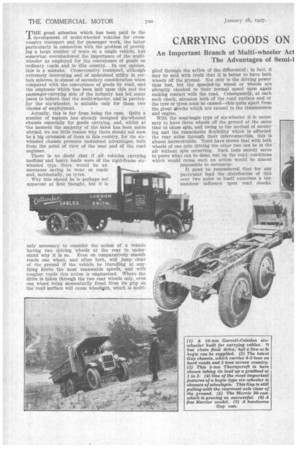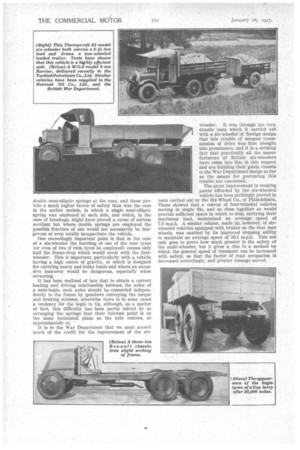CARRYING GOODS ON :-WHEELED VEHICLES.
Page 54

Page 55

Page 56

Page 57

If you've noticed an error in this article please click here to report it so we can fix it.
THE great attention which has been paid to the development of multi-wheeled vehicles for crosscountry transport and for passenger work, the latter particularly in connection with the problem of providj.ng a large number of seats on a single vehicle, has somewhat overshadowed the importance of the multiwheeler as employed for the conveyance of goods on ordinary toads and in this country. In our opinion, this is a mistake. Cross-country transport, although 'extremely interesting and of undoubted utility in certain spheres, is almost of secondary consideration when compared with the conveyance of goods by road, and the emphasis which has been laid 'upon this and -the passenger-carrying side of the industry has led, many users to believe that the multi-wheeler, and in particuar the six-wheeler, is suitable only for these two clasSes of employment.
Actually, this is far from being the case. Quite a number _of makers has already designed six-wheeled chassis especially for goods carrying, and, whilst at 'the moment the majority of the sales has been made abroad, we see little reason why there should not soon be a big extension of them in this country, for the sixwheeled chassis presents undoubted advantages, both from the point of view of the user and of the road engineer.
There is no doubt that if all vehicles carrying medium and heavy loads were of the rigid-frame sixwheeled type there would be an enormous saving in wear on roads and, incidentally, on tyres.
Why this should be is perhaps not apparent at first thought, but it is only necessary to consider the action of a vehicle having two driving wheels at the rear to understand why it is so. Even on comparatively smooth roads one wheel, and often both, will jump clear of the ground if the vehicle be travelling at anything above the most reasonable speeds, and with rougher roads this action is emphasized. Where the drive is taken through the two rear wheels only, even one wheel being momentarily freed from its grip on the road surface will cause wheeltipin, which is multi plied through the action of the differential; in fact, it may be said with truth that it is better to have both wheels off the ground. Not only is the driving power thus lost, but the Speeded-up wheel or wheels are abruptly checked to their normal speed upon again making contact with the road. Consequently, at each such check, abrasion both of the road surface and of the tyre or tyres must be caused—this quite apart from the great shocks which are caused to the transmission and engine.
With the semi-bogie type of six-wheeler it is necessary to have three wheels off the ground at the same time to cause spin, and owing to the method of mounting and the remarkable flexibility which is afforded the rear axles through their interconnection, this is almost inconceivable. Tests have shown that with both wheels of one axle driving the other two can be in the air without spin occurring. Such tests merely serve to prove what can be done, but, on the road, conditions which would cause such an action would be almost impossible to encounter.
It must be remembered that for any particular load the _distribution of this over two axles in itself exercises a tremendous influence upon road shocks, whilst the semi-bogie mounting, which is now employed almost universally on six-wheelers, reduces the rise and fall of a frame to at least half of what it would be were two wheels only employed at the rear, so that the resulting shock is less than a quarter of that experienced with the ordinary type of vehicle.
This is a matter of vital importance, particularly where vehicles are being operated at fairly high speeds, for In the ordinary course shocks depend rather more upon speed than upon load, and it is usually considered necessary at least to double the static load on a wheel when considering the shock load which occurs under run n ing conditions.
An extremely important point in considering the sixwheeler is its practical immunity from serious skids. This is partly due to the increased area of tread in
contact with the road and partly due to the absence of wheelspin, which in itself is one of the most potent factors in causing skidding.
Another advantage is that four-wheel braking can be achieved far more easily and readily with the sixwheeler than with the ordinary type of chassis. By merely utilizing a drum with a single pair of shoes on each wheel, applying the brakes on either axle will ensure braking on the other, but, of course, this applies also to a brake, if any, on the transmission:
The employment of six-wheeled vehicles also permits the more practicable employment of pneumatic tyres, even for comparatively heavy loads, without having recourse to excessively large sections with correspondingly high air pressures. In this connection we may refer to the fact that, whereas in the ordinary vehicle a set of rear tyres would have approximately half the life of those on the front wheels, in the six-wheelers the life is about equal, and it has already been proved that the actual wear on the tyres of a six-wheeler is so much less than on those of a four-wheeler that there is a direct saving in this way alone. It may be termed a saving in rubber consumption and, as such, deserves consideration.
Many—in fact, we may almost say all—of the latest six-wheelers designed for the carrying of goods have 033
double semi-elliptic springs at the rear, and these provide a much higher factor of safety than was the case in the earlier models, in which a single semi-elliptic spring was employed at each side, and which, in the case of breakage, might have proved a cause of serious accident but where double springs are employed the possible fracture of one would not necessarily be dangerous or even totally incapacitate the vehicle.
One exceedingly important point is that in the case of a six-wheeler the bursting of one of the rear tyres (or even of two if twin tyres be employed) causes only half the frame-drop which would occur with the fourwheeler. This is important, particularly with a vehicle having a high centre of gravity, or which is designed for carrying heavy and bulky loads and where an excessive lean-over would be dangerous, especially when cornering.
It has been realized of late that to obtain a correct loading and driving relationship between the axles of a semi-bogie, such axles should be connected independently to the frame by members conveying the torque and braking stresses, otherwise there is in some cases a tendency for the bogie to tip, although, as a matter of fact, this difficulty has been partly solved by so arranging the springs that their fulcrum point is on the same horizontal plane as the axle centres, or approximately so.
It is to the War Department that we must accord much of the credit for the improvement of the six
wheeler. It was through the very, drastic tests which it carried out with a six-wheeler of foreign design that this trouble of unequal 'transmission of drive was first brought into prominence, and it is a striking fact that practically all the manufacturers of British six-wheelers have come into line in this respect and are building their goods chassis to the War Department design so far as the means for preventing this trouble are concerned.
The great improvement in braking power afforded by the six-wheeled vehicle has been strikingly proved in tests carried out by the Six-Wheel Co., of Philadelphia. These showed that a convoy of four-wheeled vehicles moving in single ille, and so close together as would provide sufficient space in which to stop, carrying their maximum load, maintained an average speed of 7.3 m.p.h. A similar column, made up, however, of sixwheeled vehicles equipped with brakes on the four rear wheels, was enabled by its improved stopping ability to maintain an average speed of 16.1 m.p.h. This not only goes to prove how much greater is the safety of the multi-wheeler, but it gives a clue to a method by which the general speed of transport can be increased with safety, so that the factor of road occupation is decreased accordingly, and greater tonnage moved. Other tests have shown that there is a total saving of at least 25 per cent, in the crude rubber employed for the tyres and normally lost by abrasion. Tyre contracts on a basis of from 20,000 miles to 30,000 miles of service are now being made for six-wheelers, and this figure is authenticated by the experience of Guy Motors, Ltd., which has a six-wheeled lorry the rear tyres of which have covered over 20,000 miles without being changed and without experiencing trouble through Punctures ; even after this service the tyres were in excellent condition and apparently capable of a good many more thousands. Of miles.
British makers of six-wheeled vehicles have contented themselves with developing vehicles for comparatively light loads,' but at least two—the Caledon, which is now being manufactured by Richard Garrett and Sons, Ltd., and 'a steam model, also a product of the' Garrett works—have been built for loads up to 10 tons. Sueh weights could not possibly be carried on an ordinary four-wheeled vehicle, as the axle load at the rear would be far above the legal limit.
There is still a doubt as to the position regarding .the distribution of the axle weights, but a sensible view has apparently been taken pending official recognition. It has been realized that, although the bogie axles-of a six-wheeler are comparatively close together, yet excellent distribution of the pressure over the subsoil is obtained ; in fact, pressures due to impact are, in the six-wheeler, approximately a quarter of those on the four-wheeler, where the individual axle weights are the same. There is no such thing as weight concentration in the case of the six-wheeler; consequently, the risk of road damage is considerably less with a 10-ton load than is the case with a 5-tonner on four wheels.












































































































